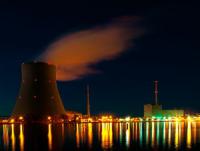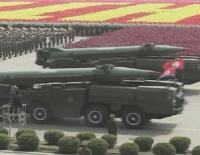-
If Trump wants nuclear war, virtually no one can stop him
The general in charge of America’s nuclear arsenal, John Hyten, recently said he would resist carrying out an illegal order from the president to use those weapons. His comments echoed the ones made a few days earlier by one of his predecessors, retired Air Force Gen. Robert Kehler. While the generals are no doubt military men of integrity, my four decades of experience as a diplomat and scholar of American foreign policy suggest there is no law that would make a presidential order to launch a preemptive nuclear strike on North Korea illegal. The bottom line is that a nuclear war won’t be prevented by military officers refusing to obey an order they consider illegal. And such a situation won’t be avoided by congressional action. The legislative branch is paralyzed by partisan politics. Using the bomb is up to the discretion of a president who came to office with no experience in the military, government or foreign affairs beyond real estate deals in other countries. And after ten months of on-the-job training, he seems no better prepared for such a responsibility.
-
-
Why nuclear deterrence could work on North Korea
The same logic that kept a nuclear war from breaking out between the United States and former Soviet Union is the best strategy to now pursue with North Korea, several scholars said last week at Stanford. The discussion revolved around whether North Korea will have the ability to strike the U.S. with nuclear warheads, and can the U.S. depend on a deterrence strategy like it did during the Cold War? Deterrence theory holds that nuclear weapons are intended to deter other states from attacking with their nuclear weapons, through the promise of retaliation and possibly mutually assured destruction.
-
-
Nuclear energy programs do not increase likelihood of nuclear weapons proliferation: Study

Contrary to popular thought, nuclear proliferation is not more likely to occur among countries with nuclear energy programs, according to new research. In a historical analysis of the relationship between nuclear energy programs and proliferation from 1954 to 2000, the study finds that the link between the two has been overstated. “The findings suggest that international efforts to manage the proliferation risks of nuclear energy programs have been quite effective,” says the study’s author. “Even when countries become more technically capable of developing nuclear weapons due to an energy program, they can often be restrained by timely intelligence and the prospect of sanctions.”
-
-
200 killed in tunnel collapse at North Korea nuclear test site
About 200 North Korean laborers and engineers have been killed after a mine shaft being dug at the country’s nuclear test site collapsed in early September. On 3 September, North Korea conducted a nuclear test of a bomb with a yield of about 280 kilotons (the Hiroshima and Nagasaki bombs were in the 12-15 kiloton range). Experts say that the powerful test, conducted in a neighboring tunnel, may have weakened the wall- and ceiling-support scaffolding of the tunnel which collapsed. North Korea has conducted all its nuclear tests in a tunnel network under Mount Mantap. South Korean and Chinese scientists have warned that the mountain may be suffering from “Tired mountain syndrome,” and that more tests may cause the mountain to collapse, releasing large amounts of radioactive fallout.
-
-
“North Korea crisis could spark a global chain of nuclear strikes”: Luxembourg Forum

Leading international experts on nuclear non-proliferation and world leaders met Monday in Paris for the International Luxembourg Forum on Preventing Nuclear Catastrophe to express their concern on the escalating crisis in nuclear weapons control. During his opening remarks, Tony Blair warned that “the proliferation of nuclear weapons is the most serious threat today to the fate of humankind.” Blair further said that “Proliferation begets further proliferation leading to risk of additional terrorist capability.”
-
-
Detecting nuclear materials used in dirty bombs
Radiological material falling into the wrong hands is a constant security concern for governments around the world. Border agencies must scan incoming vehicles and freight for radioactive material, which is a challenging task, as huge volumes of both move across borders each day. Imperial College London’s physicists have developed two devices for detecting nuclear materials.
-
-
Will North Korea sell its nuclear technology?
Earlier this month CIA Director Mike Pompeo suggested “the North Koreans have a long history of being proliferators and sharing their knowledge, their technology, their capacities around the world.” My research has shown that North Korea is more than willing to breach sanctions to earn cash. Over the years North Korea has earned millions of dollars from the export of arms and missiles, and its involvement in other illicit activities such as smuggling drugs, endangered wildlife products and counterfeit goods. Still, there are only a handful of cases that suggest these illicit networks have been turned to export nuclear technology or materials to other states.
-
-
Breaking nuclear deal could bring hacking onslaught from Iran
If the Trump administration discarded the nuclear deal with Iran, Tehran could retaliate quickly – and inflict considerable damage – by unleashing its increasingly aggressive Iranian hacker army. Cyber-experts who track Tehran’s hackers warn that the attacks might target U.S. power plants, hospitals, airports, and other components of the country’s critical infrastructure. Iran’s current hacking against Western targets is limited almost entirely to commercial espionage and dissident surveillance, but Teheran could quickly redirect its efforts in the event of a rupture of the nuclear pact.
-
-
The Madman Theory of North Korea
By the fall of 1969, President Richard Nixon had become increasingly frustrated with the refusal of North Vietnam to engage in meaningful negotiations with the United States. He believed that the Soviet Union was the only country able to persuade the North Vietnamese leadership to be forthcoming – but how do you get the Kremlin to apply pressure on North Vietnam? Nixon’s idea: To convince Leonid Brezhnev that Nixon was a madman, capable of irrational action. Has President Donald Trump revived the Madman Theory in order to deal with North Korea’s nukes?
-
-
No, we cannot shoot down North Korea’s missiles
The number one reason we don’t shoot down North Korea’s missiles is that we cannot. The latest North Korean missile to fly over Japan did so at 475 miles over Japan at the apogee of its flight path. Neither Japan nor the United States could have intercepted the missile. None of the U.S. theater ballistic missile defense weapons in existence can reach that high. It is hundreds of kilometers too high for the Aegis interceptors deployed on Navy ships off Japan. Even higher for the THAAD systems in South Korea and Guam. Way too high for the Patriot systems in Japan, which engage largely within the atmosphere.
-
-
World unprepared to deal with the effects of a thermonuclear attack
The world is not prepared to deal with the devastating effects of a thermonuclear attack, says an University of Georgia’s Cham Dallas. He said that the development of a hydrogen bomb by North Korea is a transformative event, especially from the point of view of the medical and public health response to a thermonuclear detonation.
-
-
North Korea threatens EMP attack on U.S.
North Korea’s relentless march toward acquiring the capability to place a hydrogen bomb on top of an ICBM will soon pose a threat to all major U.S. cities. There is another threat that marrying of a hydrogen bomb to a powerful rocket poses: An EMP threat. The North Koreans could launch a missile into the upper atmosphere, then detonate a high-yield hydrogen bomb in space in order to generate an electromagnetic pulse, or EMP, which would shut down the U.S. power grid and damage electrical devices. Experts testifying before the Congressional EMP Commission said that in the event of a massive EMP attack on the United States using multiple high-yield warheads, around 90 percent of the American population would be dead after eighteen months due to famine, disease, and societal breakdown.
-
-
Why didn’t sanctions stop North Korea’s missile program?
North Korea’s long-range missile program has made significant technological advances in the past few months. For most of the past twenty years, the international community has struggled to stop this kind of progress by imposing a series of severe sanctions on the country. Have sanctions failed? This question is complicated, but what is undeniable is that sanctions have had unforeseen consequences by making North Korea’s procurement efforts more sophisticated as Chinese middlemen monetize the risk. Americans tend to view North Korea as an inward-looking, economically isolated state cut off from the international community. However, the country’s illicit networks – including those supplying its missile program – are global and responsive. Ultimately, they will be difficult to counter.
-
-
Trump can’t win: The North Korea crisis is a lose-lose proposition for the United States
There seems to be no outcome from this crisis in which U.S. power is enhanced. There are no avenues for the Trump administration to demonstrate strength and resolve that do not ultimately expose the limitations of that strength. Could current events on the Korean Peninsula represent America’s “Suez Crisis” moment? In 1956, Britain over-reached in its attempt to maintain a post-war imperial toehold in Egypt, exposing the chasm between its imperial pretensions of a bygone era and its actual power in the aftermath of the second world war. The North Korea crisis is the most obvious face of hegemonic transition. Trump’s United States is facing a set of outcomes to the current crisis that are lose-lose. They are exposing the reality of U.S. decline and the growing limitations of its ability to shape the strategic environment in northeast Asia.
-
-
Weapons experts: IAEA needs full access to Parchin to understand Iran’s nuclear program
In order to understand Iran’s nuclear weapons program, the International Atomic Energy Agency (IAEA) needs full access to Iran’s Parchin military installation, two experts on nuclear weapons wrote in a report published Monday. The report’s authors wrote that the IAEA has inadequate means to investigate possible Iranian violations of the nuclear deal, known as the Joint Comprehensive Plan of Action (JCPOA).
-
- All
- Regional
- Water
- Biometrics
- Borders/Immig
- Business
- Cybersecurity
- Detection
- Disasters
- Government
- Infrastructure
- International
- Public health
- Public Safety
- Communication interoperabillity
- Emergency services
- Emergency medical services
- Fire
- First response
- IEDs
- Law Enforcement
- Law Enforcement Technology
- Military technology
- Nonlethal weapons
- Nuclear weapons
- Personal protection equipment
- Police
- Notification /alert systems
- Situational awareness
- Weapons systems
- Sci-Tech
- Sector Reports
- Surveillance
- Transportation
Advertising & Marketing: advertise@newswirepubs.com
Editorial: editor@newswirepubs.com
General: info@newswirepubs.com
2010-2011 © News Wire Publications, LLC News Wire Publications, LLC
220 Old Country Road | Suite 200 | Mineola | New York | 11501
Permissions and Policies
Editorial: editor@newswirepubs.com
General: info@newswirepubs.com
2010-2011 © News Wire Publications, LLC News Wire Publications, LLC
220 Old Country Road | Suite 200 | Mineola | New York | 11501
Permissions and Policies
